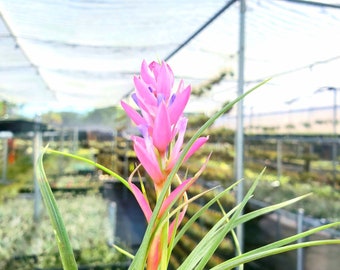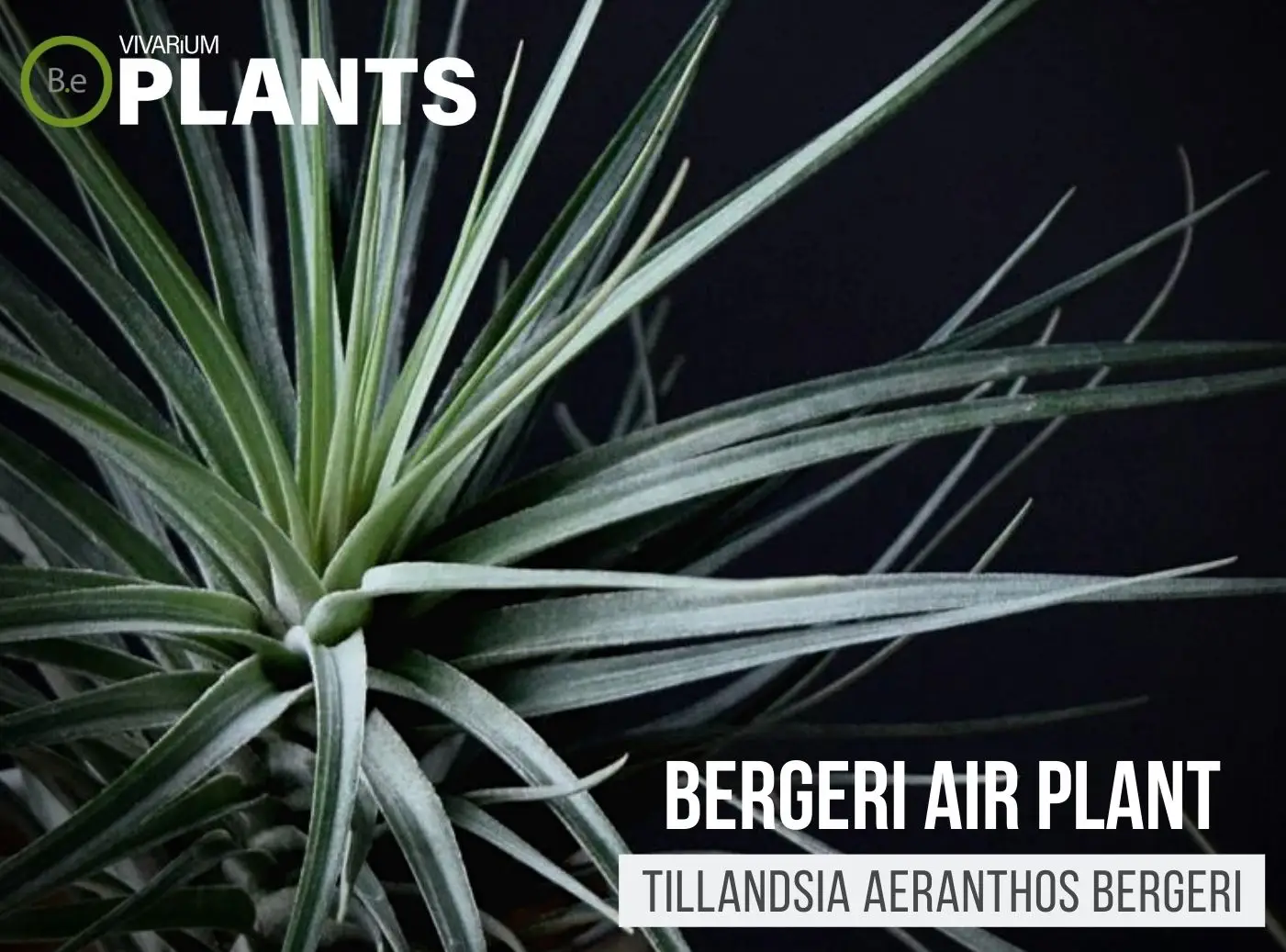Tillandsia stricta is a fantastic display specimen in a vivarium if you’re looking for some unique accent greenery that strives in truly unique environments. Since the Stricta air plant is a terrarium air plant, you don’t need to worry about soil, pots, or substrate.
This tillandsia is a great safe choice for pet owners because of its non-toxicity. Though it provides such a unique aesthetic benefit to a terrarium, the Stricta air plant is considered a moderately challenging bromeliad for hobbyists to maintain;
However, its work is worth it for its bold beauty.
Quick Stats:
Scientific Name: Tillandsia stricta Sol
Family: Bromeliaceae
Common Names: Stricta Air Plant, Upright Air Plant
Habitat: Terrestrial
Height: 6 to 10 inches
pH Range: 6.0 to 8.0
Temperature: 70°F to 84°F
Lighting: Bright, diffused
What is a Tillandsia stricta?
Tillandsia stricta is a type of terrestrial bromeliad that ranges from yellow-green to grayish-green. This air plant is slow growing, relatively easy to care for, and fairly maintenance-free.
It is one of the larger air plants available with leaves reaching up to 8-10” in length. One unique feature of this plant is its ability to produce vibrant sky blue & purple blooms when given the proper conditions.


Tillandsia stricta Facts
Tillandsia stricta gets its common name, the Stricta air plant, from its ability to grow without soil or being potted. These air plants can also live with direct submersion into the water every other day, however, they still need plenty of airflow to complete their metabolic processes.
These air plants also have a great way of expressing themselves without saying a word. The tip of the leaves will go red when the air plants want more light and yellow & orange hues when the air plant is not getting enough water.
Description
Tillandsia stricta is a stunning and unique air plant, with its vibrant green rosette-like appearance. This air plant obtains its source of nutrition from the moisture it collects in its leaves rather than from the soil which is common for its Bromeliaceae family plants.
The leaves are quite stiff and are covered with trichomes that hold onto the humidity.
Habitat
The Stricta air plant is native to regions of North America such as Mexico and Central America. This air plant can be found in arid tropical forests where the humidity can get high.
The average temperatures of its natural habitats are usually in the low 70s to the high 80s.
pH Preference
Tillandsia stricta prefers a slightly alkaline soil or substrate, as it soaks up its nutrients and water, so it is important to make sure that your vivarium is not overly acidic when setting up. Ideal pH levels should range from 6.0 to 8.0.
Vivarium Type
The upright air plant is quite an easy-going species. With that in mind, it will not be too complicated when it comes to choosing the type of enclosure it is grown in. It is best to try and replicate the plant’s natural habitat as much as possible.
Doing so will make it easier to provide this air plant with its basic needs. The proper setup and theme of the enclosure will make a big difference to the overall look and health of the air plant. Be sure to choose setups that are moist and high in humidity. Here are recommended vivariums it will do well in:
- Paludariums – Half aquatic/ half terrain-based enclosure.
- Terrariums – Fully terrain-based enclosures with little to no aquatic features.
Vivarium Placement
The Stricta air plant needs to be placed in an area of the vivarium that gets bright but diffused light. Since this air plant can’t soak up root tabs or any type of substrate, Tillandsia stricta does better when hung rather than placed in soil. Hooks and fishing lines can be used for this purpose.
Substrate
The Stricta air plant does not need soil or substrate as it obtains its nutrients through its leaves. If you decide to include it in a soil substrate environment, you should make sure that the soil is well-draining, as the plant may rot if there is too much moisture in its environment.
Lighting
Tillandsia stricta needs full, bright, and diffused terrarium light. Leaving the air plant in a shady area will cause it to stretch out and will not produce its beautiful blooms.
You can provide the air plant with some artificial lighting such as LEDs during the winter season in order to achieve more bright and diffused light.
Buy Tillandsia stricta
When it comes to buying the Stricta air plant, there are a few things to keep in mind. Making sure the plant is healthy when purchased is essential for its success in a vivarium. Vegetation that is already in poor conditions will have a very hard time adjusting to new environments.
Click the image below to find out more about the current price and other relative info about this plant.
Tillandsia stricta Care and Propagation
Tillandsia stricta does not need over-the-top care like other plants might, as it is a relatively easy air plant to maintain and propagate. This air plant will automatically propagate itself by reproducing pups and can also be propagated by cutting segments of already established air plants.
How to Grow
The Stricta air plant should be misted or soaked at least every week. If in an arid climate, they should be soaked every other day or misted twice a day. Check to make sure that the leaves have enough moisture by breaking off a few trichomes, this should reveal if it is adequately hydrated or not.
Watering
It is important to make sure that the Tillandsia stricta is watered every 1-2 weeks and that it is given enough air circulation. Soaking in a bowl of room temperature water for 20-30 minutes every week will give the plant enough of the hydration needed to keep it alive.
Misting the plant at least once a week is tolerable as well.
Plants Similar to Stricta
Adding diversity to an enclosure is key to an aesthetically pleasing setup. Try mixing up the look of your vivarium with different flora that can easily co-exist in the same types of environment. Furthermore, if you find the upright air plant hard to acquire or would like to consider something similar to this plant… Here are other air plants you might find will do well with or in the place of Tillandsia stricta:
Conclusion
Tillandsia stricta is a great air plant for beginner to intermediate-level hobbyists. Though it is considered a challenging species to keep alive, with a little bit of patience the lush beauty of the upright air plant makes it well worth the effort.
This air plant is a great addition to any vivarium, adding a unique dimension to any terrarium setup. Its beautiful blooms make this terrarium plant a conversation starter that will be sure to draw attention.
Frequently Asked Questions
1. Provide Bright, Indirect Light: Tillandsia Stricta needs bright, indirect light. Place plants in front of an east or west-facing window. Avoid direct northern or southern exposures, as these can be too intense.
2. Mist with Water: This type of air plant should be misted with water at least 2-3 times a week. Use filtered or distilled water whenever possible to reduce the possibility of mineral build-up on leaves.
3. Soak in Water: Once a week, submerge Tillandsia Stricta in water for a few hours. Use the same filtered or distilled water recommended for misting.
4. Provide Proper Air Flow: Another important factor in caring for Tillandsia Stricta is providing good air circulation. When kept indoors in a humidity-controlled environment, a small fan can help keep air plants healthy.
5. Feed with Fertilizer: You can fertilize Tillandsia Stricta every two weeks by adding liquid fertilizer to the misting water. Use a fertilizer formulated for tillandsias or one that is low in nitrogen.
Plant Tillandsia Stricta by soaking the roots in water for 30 minutes and then planting in a loose, well–draining medium such as bark, sand, or perlite. Place in a warm and light area, making sure to mist the leaves with water regularly.




